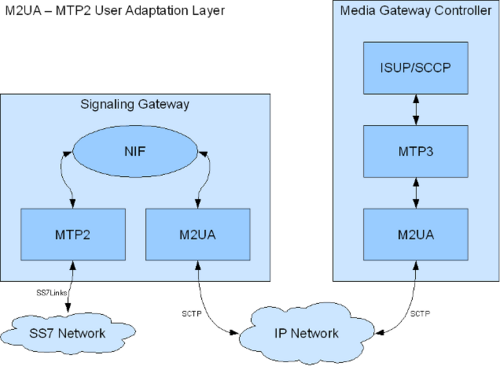M2UA
From TBwiki
(Difference between revisions)
(Added links to newer versions) |
|||
| (4 intermediate revisions by 2 users not shown) | |||
| Line 1: | Line 1: | ||
| − | The M2UA (Message Transfer Part 2 User Adaptation Layer) is used to interface [[MTP2 Layer|MTP2]] of the signaling gateway to the [[MTP3 Layer|MTP3]] of a media gateway controller. M2UA can also be seen as way to extend | + | The M2UA (Message Transfer Part 2 User Adaptation Layer) is used to interface the [[MTP2 Layer|MTP2]] of the signaling gateway to the [[MTP3 Layer|MTP3]] of a media gateway controller. M2UA can also be seen as way to extend an MTP2 link. An M2UA link is always bound to an MTP2 link. |
| − | + | The following diagram illustrates the setup using M2UA: | |
| Line 8: | Line 8: | ||
| − | + | The M2UA layer can interface with either a NIF or an MTP3 layer; therefore, M2UA has two modes of operation. Furthermore, Toolpack can configure M2UA in both modes. | |
| Line 14: | Line 14: | ||
TelcoBridges supports M2UA as part of its [[SIGTRAN]] implementation. | TelcoBridges supports M2UA as part of its [[SIGTRAN]] implementation. | ||
| + | == Sigtran use cases == | ||
| + | You can see some use cases for Sigtran here: [[Use_Cases:Sigtran_Configuration_A|Sigtran use cases]] | ||
== Configuration == | == Configuration == | ||
| + | *[[Toolpack:Protocol_Stack_Settings_E#Signaling|M2UA configuration v3.2]] | ||
*[[Toolpack:Protocol_Stack_Settings_D#M2UA|M2UA configuration v3.0]] | *[[Toolpack:Protocol_Stack_Settings_D#M2UA|M2UA configuration v3.0]] | ||
| − | |||
*[[Toolpack:Protocol_Stack_Settings_B#M2UA|M2UA configuration v2.9]] | *[[Toolpack:Protocol_Stack_Settings_B#M2UA|M2UA configuration v2.9]] | ||
| − | |||
<div class="mw-collapsible mw-collapsed" data-collapsetext="other versions" data-expandtext="Click here for other versions" style="width: 400px;"> | <div class="mw-collapsible mw-collapsed" data-collapsetext="other versions" data-expandtext="Click here for other versions" style="width: 400px;"> | ||
| + | *[[Toolpack:Protocol_Stack_Settings_C#M2UA|M2UA configuration v2.10]] | ||
| + | *[[Toolpack:Protocol_Stack_Settings_A#M2UA|M2UA configuration v2.8]] | ||
*[[Web_Portal_Tutorial_Guide_v2.7#M2UA|M2UA configuration v2.7]] | *[[Web_Portal_Tutorial_Guide_v2.7#M2UA|M2UA configuration v2.7]] | ||
</div> | </div> | ||
| Line 28: | Line 31: | ||
*RFC 3331 Signaling System 7 (SS7) Message Transfer Part 2 (MTP2) - User Adaptation Layer | *RFC 3331 Signaling System 7 (SS7) Message Transfer Part 2 (MTP2) - User Adaptation Layer | ||
| + | == Other links == | ||
| + | *[[Use_Cases:M3UA_A|M3UA configurations]] | ||
[[category:Glossary]] | [[category:Glossary]] | ||
| − | |||
[[Category:Revise on Major]] | [[Category:Revise on Major]] | ||
Latest revision as of 08:58, 21 January 2021
The M2UA (Message Transfer Part 2 User Adaptation Layer) is used to interface the MTP2 of the signaling gateway to the MTP3 of a media gateway controller. M2UA can also be seen as way to extend an MTP2 link. An M2UA link is always bound to an MTP2 link.
The following diagram illustrates the setup using M2UA:
The M2UA layer can interface with either a NIF or an MTP3 layer; therefore, M2UA has two modes of operation. Furthermore, Toolpack can configure M2UA in both modes.
Contents |
TelcoBridges and M2UA
TelcoBridges supports M2UA as part of its SIGTRAN implementation.
Sigtran use cases
You can see some use cases for Sigtran here: Sigtran use cases
Configuration
References
- Article at Protocols.com
- RFC 3331 Signaling System 7 (SS7) Message Transfer Part 2 (MTP2) - User Adaptation Layer
